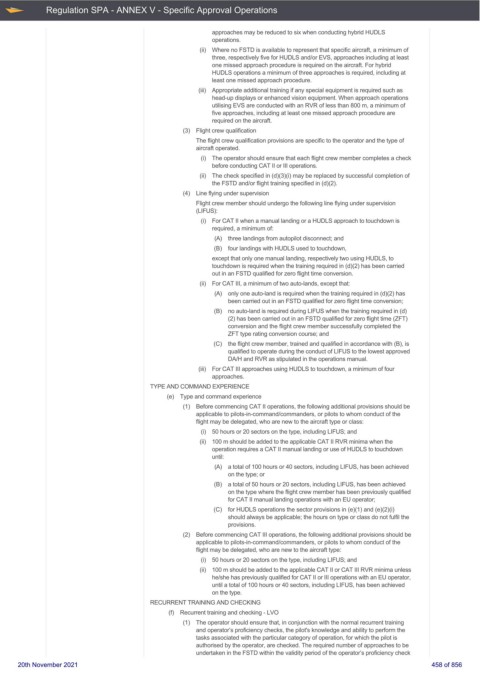Page 458 - UK Air Operations Regulations 201121
P. 458
~
~ Regulation SPA - ANNEX V - Specific Approval Operations Centrik
approaches may be reduced to six when conducting hybrid HUDLS
operations.
(ii) Where no FSTD is available to represent that specific aircraft, a minimum of
three, respectively five for HUDLS and/or EVS, approaches including at least
one missed approach procedure is required on the aircraft. For hybrid
HUDLS operations a minimum of three approaches is required, including at
least one missed approach procedure.
(iii) Appropriate additional training if any special equipment is required such as
head-up displays or enhanced vision equipment. When approach operations
utilising EVS are conducted with an RVR of less than 800 m, a minimum of
five approaches, including at least one missed approach procedure are
required on the aircraft.
(3) Flight crew qualification
The flight crew qualification provisions are specific to the operator and the type of
aircraft operated.
(i) The operator should ensure that each flight crew member completes a check
before conducting CAT II or III operations.
(ii) The check specified in (d)(3)(i) may be replaced by successful completion of
the FSTD and/or flight training specified in (d)(2).
(4) Line flying under supervision
Flight crew member should undergo the following line flying under supervision
(LIFUS):
(i) For CAT II when a manual landing or a HUDLS approach to touchdown is
required, a minimum of:
(A) three landings from autopilot disconnect; and
(B) four landings with HUDLS used to touchdown,
except that only one manual landing, respectively two using HUDLS, to
touchdown is required when the training required in (d)(2) has been carried
out in an FSTD qualified for zero flight time conversion.
(ii) For CAT III, a minimum of two auto-lands, except that:
(A) only one auto-land is required when the training required in (d)(2) has
been carried out in an FSTD qualified for zero flight time conversion;
(B) no auto-land is required during LIFUS when the training required in (d)
(2) has been carried out in an FSTD qualified for zero flight time (ZFT)
conversion and the flight crew member successfully completed the
ZFT type rating conversion course; and
(C) the flight crew member, trained and qualified in accordance with (B), is
qualified to operate during the conduct of LIFUS to the lowest approved
DA/H and RVR as stipulated in the operations manual.
(iii) For CAT III approaches using HUDLS to touchdown, a minimum of four
approaches.
TYPE AND COMMAND EXPERIENCE
(e) Type and command experience
(1) Before commencing CAT II operations, the following additional provisions should be
applicable to pilots-in-command/commanders, or pilots to whom conduct of the
flight may be delegated, who are new to the aircraft type or class:
(i) 50 hours or 20 sectors on the type, including LIFUS; and
(ii) 100 m should be added to the applicable CAT II RVR minima when the
operation requires a CAT II manual landing or use of HUDLS to touchdown
until:
(A) a total of 100 hours or 40 sectors, including LIFUS, has been achieved
on the type; or
(B) a total of 50 hours or 20 sectors, including LIFUS, has been achieved
on the type where the flight crew member has been previously qualified
for CAT II manual landing operations with an EU operator;
(C) for HUDLS operations the sector provisions in (e)(1) and (e)(2)(i)
should always be applicable; the hours on type or class do not fulfil the
provisions.
(2) Before commencing CAT III operations, the following additional provisions should be
applicable to pilots-in-command/commanders, or pilots to whom conduct of the
flight may be delegated, who are new to the aircraft type:
(i) 50 hours or 20 sectors on the type, including LIFUS; and
(ii) 100 m should be added to the applicable CAT II or CAT III RVR minima unless
he/she has previously qualified for CAT II or III operations with an EU operator,
until a total of 100 hours or 40 sectors, including LIFUS, has been achieved
on the type.
RECURRENT TRAINING AND CHECKING
(f) Recurrent training and checking - LVO
(1) The operator should ensure that, in conjunction with the normal recurrent training
and operator’s proficiency checks, the pilot's knowledge and ability to perform the
tasks associated with the particular category of operation, for which the pilot is
authorised by the operator, are checked. The required number of approaches to be
undertaken in the FSTD within the validity period of the operator’s proficiency check
20th November 2021 458 of 856

